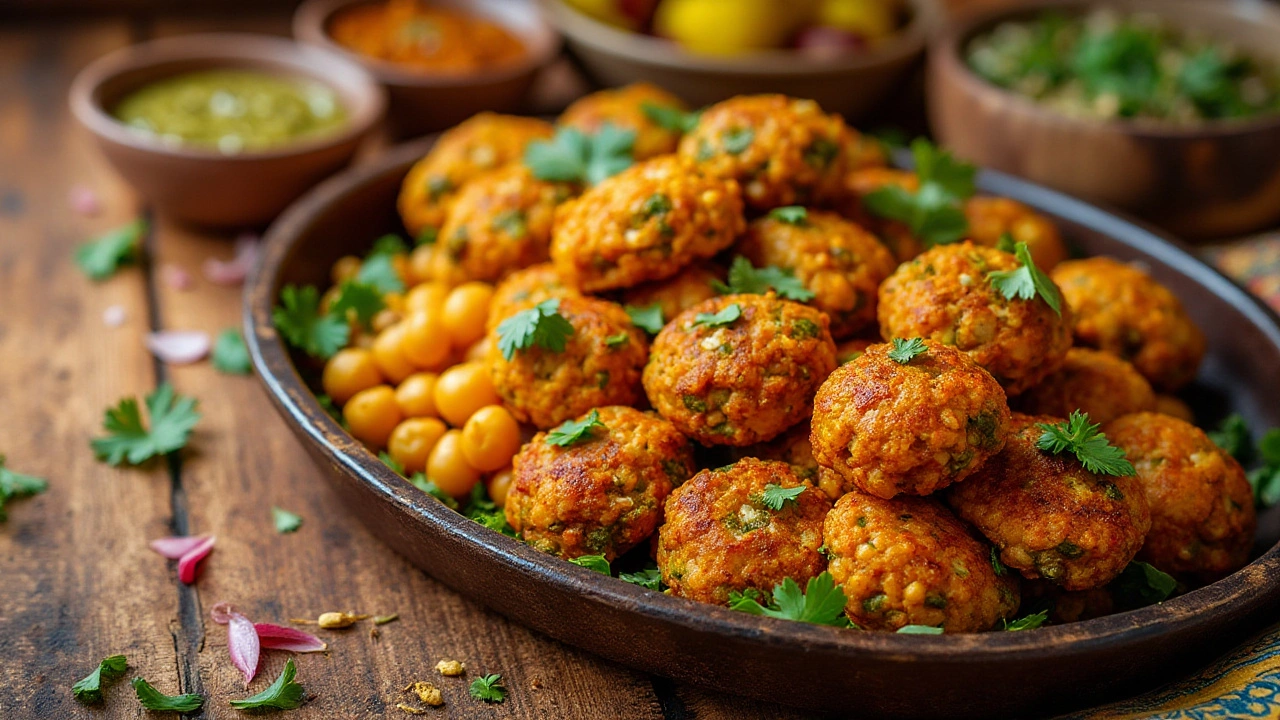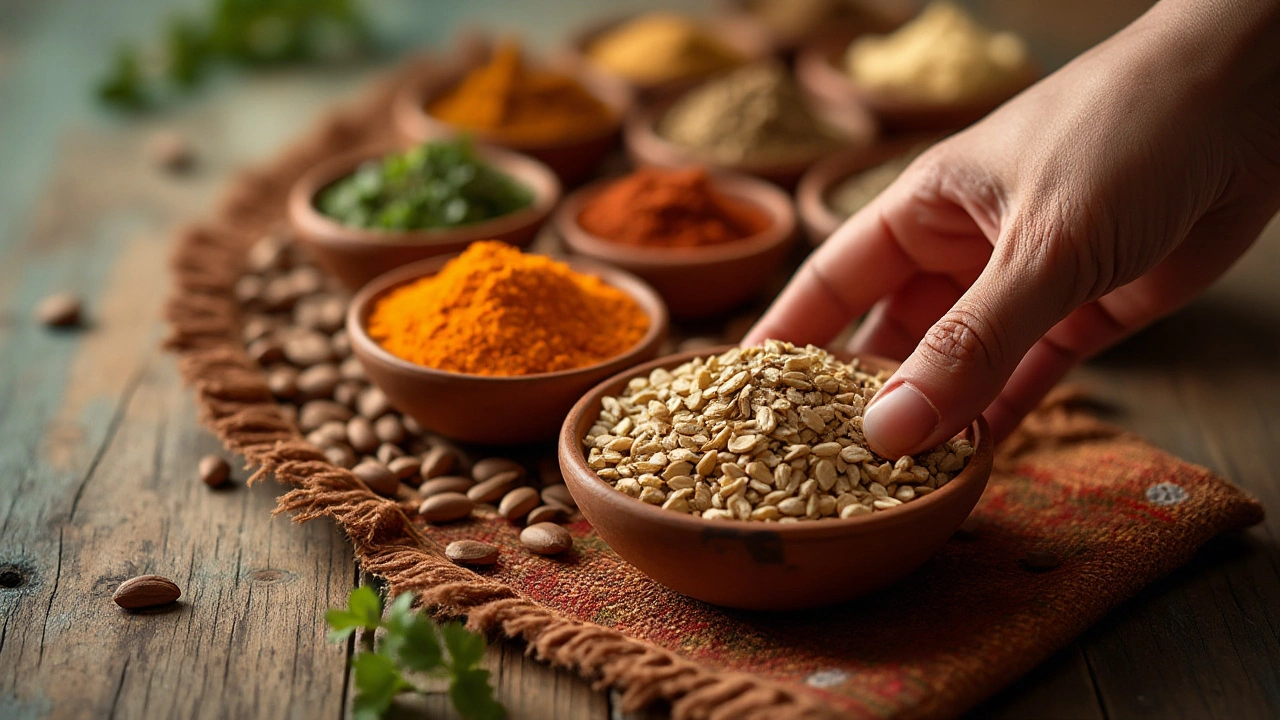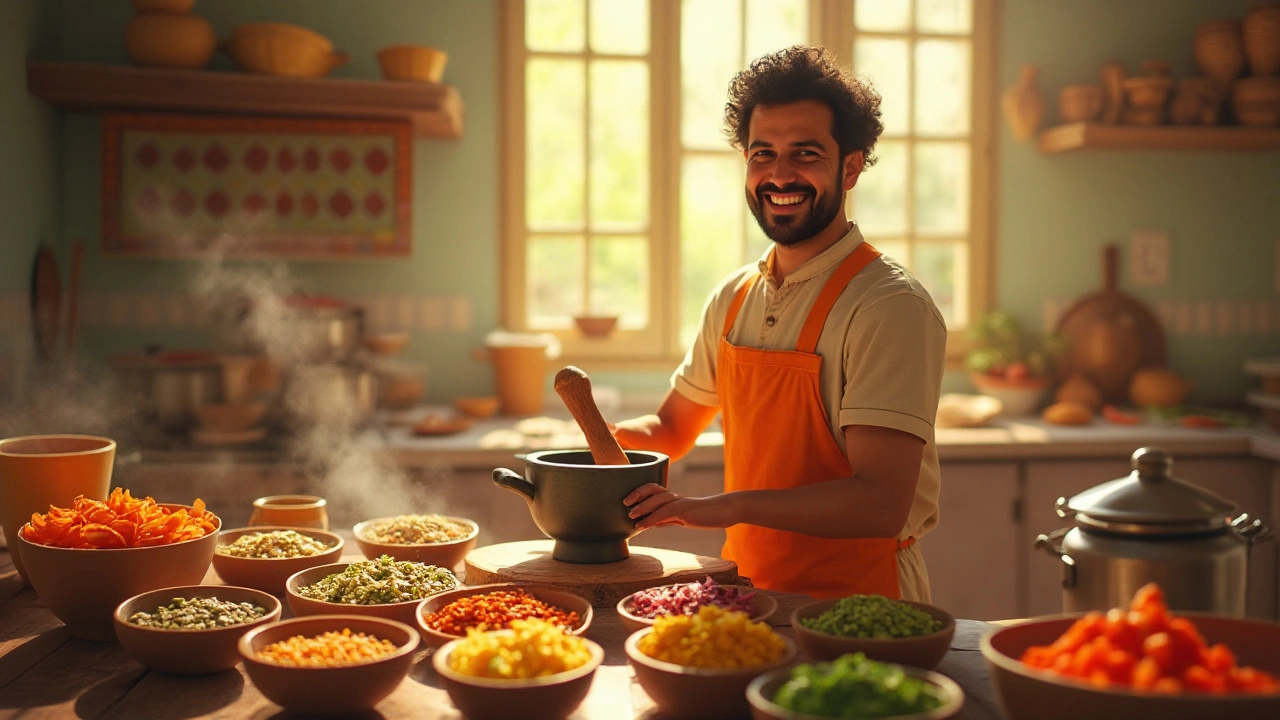In the journey towards maintaining a healthy lifestyle, snacking often presents quite the dilemma. It's easy to find oneself reaching for chips or sweets during those mid-afternoon hunger pangs. But what if snacking could be both enjoyable and nourishing? Enter the world of Indian snacks.
Rich in tradition, Indian snacks pack a punch of flavors while still catering to health-conscious individuals. Whether it's the crunchy goodness of roasted chickpeas or the vibrant burst of spice in a classic bhel puri, these snacks stand out for their unique ability to marry taste with nutrition. Let's dive into the delicious and diverse world of Indian snacks, designed to keep you both satisfied and healthy.
- Understanding Healthy Ingredients
- Popular Indian Snack Ideas
- DIY Snack Recipes
- Benefits and Nutritional Value
Understanding Healthy Ingredients
When it comes to crafting healthy snacks, Indian cuisine provides a bounty of ingredients that not only excite the palate but also enrich the body. Traditional ingredients often found in Indian snacks include lentils, chickpeas, and a variety of spices, all of which contribute significantly to their nutritional profile. Lentils, a staple in Indian cooking, are particularly renowned for being a rich source of protein, which is essential for body repair and growth. Notably, they contain dietary fiber, aiding in digestion and making you feel fuller longer, which is a boon for those mindful of their diet.
Chickpeas also play a crucial role in the creation of nutritious snacks such as chana chaat and chickpea curry. They are well-loved not only for their nutty taste but also for their ability to serve as a plant-based protein. What's remarkable about chickpeas is their capability to stabilize blood sugar, thanks to their low glycemic index. This is especially beneficial for those with diabetes or insulin resistance. According to Nutritionist Rujuta Diwekar, "Indian snacks, when made with the right ingredients, can rival the best health foods globally because of their high fiber and protein content."
Spices in Indian cuisine are more than mere flavor enhancers; they carry numerous health benefits. Turmeric, for instance, has been used in traditional medicine for centuries due to its anti-inflammatory properties. Consuming turmeric can assist in reducing joint pain and inflammation, which is important for maintaining an active lifestyle. Similarly, the use of cumin and coriander seeds often found in snacks like pakoras boosts digestion and offers antimicrobial benefits. These spices not only make dishes tastier but also contribute to a healthier immune system.
Finally, vegetables like spinach, carrots, and bell peppers are commonly incorporated into Indian snack ideas, providing essential vitamins and minerals. Including these in snacks like vegetable cutlets or carrot koshimbir ensures that one receives ample doses of vitamin A, vitamin C, and potassium. Such nutrients are vital for maintaining healthy skin and a robust immune system. By understanding how these ingredients work together, one can appreciate the prowess of Indian culinary tradition in offering snacks that are flavorful, satisfying, and deeply nutritious.

Popular Indian Snack Ideas
India is a land known for its vibrant cultural diversity, and this richness is beautifully reflected in its snack ideas. Whether you're looking for something to munch on while relaxing at home or a quick bite during a hectic day, Indian snacks present a flavorful path to explore. One of the most beloved snacks is the humble bhel puri. A savory concoction of puffed rice, chopped onions, tomatoes, boiled potatoes, and chutneys, it is a delightful combination of textures and flavors. The tangy and spicy notes of bhel puri not only make it a popular street food but also a great healthy snack when prepared with minimal oil.
Chaats: A Symphony of Flavors
Another captivating segment of Indian snacks is the world of chaats. These tangy, spicy, and sweet savouries are often considered a must-try for anyone venturing into Indian cuisine. Take, for instance, pani puri, also known as golgappa or puchka. This delicacy comprises small, hollow puris filled with a spicy tangy water, tamarind sauce, chickpeas, and potatoes. The burst of flavors with each bite of pani puri is an experience cherished by many. Additionally, dahi puri offers a sweet and savory twist with the addition of yogurt, making it a creamy variant. The beauty of chaats lies not just in their taste but also in their potential to offer a wholesome experience with chickpeas and spices that can be quite nutritious.
"The snack idea is to combine the richness of both spices and herbs, creating a unique fusion that enhances the health benefits of every bite." – Food Historian, Haris Mehyar
South Indian Delights
Beyond the street food fare, South Indian snack offerings provide a different approach. Items like idli and dosa are not only staples in South Indian households but have also gained international recognition. Made from fermented rice and lentil batter, idlis are often enjoyed with a side of sambhar, a lentil-based vegetable stew, and coconut chutney. Their fermented batter enhances gut health and provides essential nutrients. Similarly, dosa, a thin pancake-like dish, can be filled with various fillings. Masala dosa, filled with spiced potatoes, is particularly popular. The versatility and nutrient value of these snacks make them perfect for any diet-conscious individual searching for a nutritious snack.
Sweet Indulgences
For those with a sweet tooth, Indian snacks don't disappoint either. Although traditionally often indulgent, modern variations provide healthier alternatives. Take ladoos, for instance. Originally prepared with ghee and sugar, variations like ragi ladoo and oats ladoo incorporate whole grains and nuts to add a nutrient boost. Similarly, the beloved halwa, usually made with semolina, can be crafted from carrot or pumpkin to ensure a healthier yet tasty treat. These snacks show that indulgence need not come at the cost of health, offering a spectrum of flavours that cater to the sweet cravings while keeping an eye on nutrition.
An intriguing fact is that many Indian snacks, like roasted Bengal gram or moong dal, are rich in protein and fiber, supporting both satiety and digestive health. While often modest in appearance, these snacks pack a powerful punch of nutrients, ensuring that snacking remains both enjoyable and beneficial.

DIY Snack Recipes
For anyone looking to add a personal touch to their snack routine, crafting your own snacks at home can be a rewarding (and delicious) endeavor. Not only does making snacks yourself let you control the ingredients you use, but it also ensures that you won't find unexpected preservatives sneaking their way into your diet. Let's explore some exciting Indian snack recipes that you can whip up in the comfort of your kitchen.
One of the simplest yet highly satisfying snacks you can make is the ever-popular roasted chickpeas. These tiny legumes are easy to work with and pack a hefty crunch, making them the perfect snacking companion. Begin by soaking dried chickpeas overnight, then boil them until they are tender. Draining and patting them dry is crucial as it aids in achieving that much-desired crunch. Toss the chickpeas in olive oil, a sprinkle of salt, and your choice of spices—cumin and coriander powder always bring a delightful aroma to the kitchen. Spread them evenly on a baking sheet and roast in the oven at 200°C until they are crispy and golden. There's a certain joy in having them straight out of the oven, each bite bursting with wholesome flavor.
For a snack with a bit of a tangy twist, our next contender is the vibrant bhel puri. Often found on the bustling streets of Indian markets, bhel puri combines puffed rice with an assortment of rich textures and tastes. To recreate this crunchy delight, mix puffed rice with diced onions, tomatoes, boiled potatoes, and some coriander that adds brightness to your dish. Add peanuts or sev (a crunchy noodle-like snack)—these provide the required crunch. Creating a dressing with tamarind chutney, mint chutney, and a squeeze of lemon juice brings everything together, giving the dish a flavor that truly pops. The key lies in assembling just before serving to maintain its crisp texture.
In the realm of sweet options, coconut ladoos make for a guilt-free indulgence, especially for those with a sweet tooth. Coconut is not only delicious but offers notable nutritional benefits with its healthy fats and fibers. Start by gently toasting desiccated coconut over a low flame until it is just fragrant. In another pan, warm milk with sugar until the sugar dissolves, and add cardamom powder for that extra aromatic touch. Gradually add the toasted coconut to the milk mixture and cook until it thickens into a sticky dough. Shape it into bite-sized balls and set them to cool. Not only are these ladoos an easy no-bake option, but they also store well, ready to fulfill those late-night cravings.
"Cooking is about creating something delicious for someone else." - Ayisha V. Robinson, Chef and Food Writer
These DIY snack ideas highlight the diversity and ease of making Indian snacks at home. Whether it's the savory crunch of a chickpea or the tang of bhel puri, these options are sure to satiate a range of taste buds without compromising on health. Once you start experimenting with these wholesome flavors, opening a packet of store-bought snacks just won't feel the same anymore. By incorporating these recipes into your routine, not only do you treat yourself to a variety of enticing flavors, but you also promote a more nutritionally balanced lifestyle.

Benefits and Nutritional Value
When it comes to healthy snacks, Indian cuisine boasts an extraordinary range of options that not only delight the taste buds but also pack in substantial nutritional benefits. This culinary tradition relies on a mix of whole grains, legumes, nuts, seeds, and fresh vegetables, making it easy to snack healthily without sacrificing flavor. Take, for instance, roasted chickpeas, also known as chana. Rich in fiber and protein, these legumes not only help in maintaining satiety but also support muscle maintenance and digestive health. The presence of iron and zinc makes them an excellent choice for boosting immunity. Scatter some Indian spices over them, and you have a snack that satisfies cravings without the guilt of empty calories. You might say nature is the best chef, each tree bearing ingredients seasoned naturally.
Consider bhel puri, a snack that exemplifies how Indian snacks blend taste with health benefits. This popular street food combines puffed rice, vegetables like tomatoes, onions, and cilantro, and a drizzle of tangy tamarind sauce. The result is a low-calorie snack abundant in complex carbohydrates, vitamins, and minerals. The puffed rice serves as a light base that provides energy without unnecessary fats. At the same time, fresh veggies contribute antioxidants and fiber, aiding in digestion and reducing inflammation. Interestingly, recent studies suggest that incorporating more complex carbs like those in bhel puri can help maintain a healthy weight and reduce the risk of chronic diseases. A colorful medley that does more than dance on your taste buds, it might just be dancing its way to a place in your heart, and indeed, in your pantry.
Try idli, a traditional South Indian snack, and you’ll discover a delightful blend of fermented rice and lentils. This combination produces a soft, fluffy cake rich in nutrients and incredibly easy to digest, thanks to the fermentation process. Fermented foods are known for their probiotic qualities, essential for maintaining gut health. A healthy digestive system is linked to many benefits such as better nutrient absorption and an enhanced immune system. As renowned nutritionist Rujuta Diwekar states,
“A traditional idli for breakfast could very well be the most potent source of vitamin B12 we have at our disposal.”
Given the rich tapestry of ingredients within Indian dishes, it's no surprise that such snacks offer substantial nutritional density. Here’s a closer look at how some common ingredients used in Indian snacks contribute to a balanced diet:
- Lentils and pulses: Powerhouses of protein and essential amino acids; they support muscle growth and repair.
- Spices: Not merely for enhancing flavor, spices like turmeric and cumin offer anti-inflammatory and digestive benefits.
- Fresh vegetables: They add vitamins A, C, and K to every dish, supporting everything from vision to skin health.
- Nuts and seeds: Providing healthy fats and omega-3s essential for brain health.
Introducing nutritious snacks like these into your everyday routine can not only satisfy hunger but also serve as a stepping stone to a healthier lifestyle. Embrace these vibrant Indian treats that whisper with spices, and their gentle yet impactful touch might just bring about a rejuvenated version of you.
